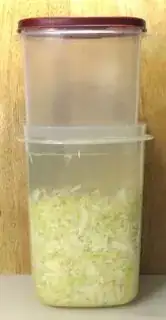I haven't done this for a very long time. I am following Alton Brown's recipe, which conveniently fits perfectly into a little hack-job of containers I already had. (Related: Why isn't glass ideal for the fermentation of sauerkraut?) @Athanasius' answer to that question led me to what I'm doing with this batch. At this point I feel pretty comfortable with it:

The two containers are identical, and I have a few inches of water in the top container so that it weighs down the cabbage in the lower container. It seems to be working pretty sweet. I'm three days in and it's starting to smell like something is happening. There is a funk in the air.
So far so good.
Now I am dying to stir it...to do something! Everything I have read (including Athanasius' answer) suggests that in a less awesome container I might have to stir, but now I don't necessarily have to do anything but scoop off scum which has yet to appear.
That's killing me.
Is there a reason not to stir? Will stirring offer any benefit?
